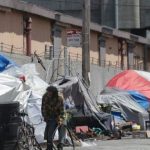President Biden loves spending the American taxpayer’s money on programs and ideas that don’t concern the average citizen. He looks to spend the money as fast as it comes in to keep the special interest and progressive left happy as he pays the monkey to keep the song and dance going. Yet, as he blows the money, the people most in need of this influx of money are left behind.
His latest debacle is hidden nicely in the Health and Human Services (HHS) budget. A $30 million grant program closed on Monday with funding to be issued beginning in May. The program will provide funding for local nonprofits and local governments to make drug use safer for addicts. While many have been making the argument that addiction needs to be treated as a disease, it’s classified as these programs rarely provide or even strongly suggest real help at getting sober.
These applications are rushed if they provide services with a focus on minorities or the LGTBQ+ persons as they are members of the “underserved community”. While the HHS has refused to specify what these programs can provide, previous programs have provided mouthpieces to prevent glass cuts, rubber bands to prevent burns, and filters to minimize the risk of diseases.
NYC, on its own, will soon begin the installation of 10 “public health” vending machines in areas that have been ravaged by drug addiction. They will provide sterile syringes, anti-overdose medication, and other “harm reduction” supplies. The goal of these machines is to keep the addicts safe and to decrease the transmission of diseases rampantly spread by addiction. Canada has had vending machines for crack pipes for some time now, but it has done little to help curb the addiction.
While other programs feature safe places to shoot up, drug testing to ensure addicts get a clean fix, and offers to get clean, many addicts either refuse to use them or are unable to get the help they need because their substance of choice isn’t covered there. These addicts are the most vulnerable as they are often the ones who have developed an addiction to prescription painkillers; something HHS provides little to no assistance with in this new program.
We have seen various ways of dealing with addiction over the years across the globe. Many countries in Europe have red-light districts where addicts can find their fix, but it is highly regulated and kept out of the public eye. The penalties for use outside of approved locations can be swift, and they provide free treatment for all addictions. In Mexico, it’s highly criminalized, and addicts are punished severely despite the level of narcotics that flow through the country daily.
To go the opposite direction and ignore the addict is a horrible thing. Many of the people who find themselves in the throes of this disease feel like there is no way out. Nobody cares, and they lose all their self-worth. For them, the addiction is ultimately the only thing they can rely on. The safe and familiar feeling of that fix is what they have to look forward to each day, and for those who find themselves on the streets as a result of their addiction, they have no choice but to keep on with the addiction because going through withdrawal without help can be deadly.
So, where do we find the balance? That is the trillion-dollar question that people have been searching for an answer to. Education is crucial to understanding addiction and how to treat it. Treatment in and of itself is a huge help, but you can only help an addict once they are truly ready to help themselves. No amount of education or treatment will keep them clean if they aren’t ready. Stiffer penalties cause more harm than good. So what is the answer? That remains to be seen, but this HHS plan isn’t it.


